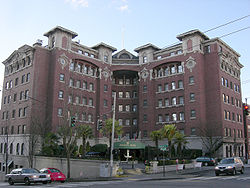
Sorrento is a town overlooking the Bay of Naples in Southern Italy. A popular tourist destination, Sorrento is located on the Sorrentine Peninsula at the south-eastern terminus of the Circumvesuviana rail line, within easy access from Naples and Pompei. The town is widely known for its small ceramics, lacework and marquetry (woodwork) shops.

Pioneer Square is a neighborhood in the southwest corner of Downtown Seattle, Washington, US. It was once the heart of the city: Seattle's founders settled there in 1852, following a brief six-month settlement at Alki Point on the far side of Elliott Bay. The early structures in the neighborhood were mostly wooden, and nearly all burned in the Great Seattle Fire of 1889. By the end of 1890, dozens of brick and stone buildings had been erected in their stead; to this day, the architectural character of the neighborhood derives from these late 19th century buildings, mostly examples of Richardsonian Romanesque.
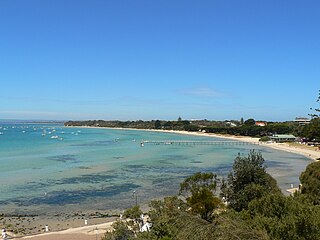
Sorrento is a coastal town on the Mornington Peninsula in Melbourne, Victoria, Australia, 61 km (38 mi) south-west of Melbourne's Central Business District, located within the Shire of Mornington Peninsula local government area. Sorrento recorded a population of 2,013 at the 2021 census.
Harry and David, LLC is an American-based premium food and gift producer and retailer. The company sells its products through direct mail, online and in retail stores nationwide, and operates the brands Harry & David, Wolferman's, Stock Yard's and Cushman's. Harry & David was founded in 1910 by Samuel Rosenberg as Bear Creek Orchards in Medford, Oregon, as a premium fruit company. As of 2014, it is owned by 1-800-Flowers.

Meridian Playground is in the Wallingford neighborhood of Seattle, Washington, United States.

The Davenport Hotel is a hotel located in Spokane, Washington. Originally a successful high-end restaurant, it is one of the possible places where the first Crab Louis was created and served. The hotel was designed by architect Kirtland Cutter and built in 1914 for $2 million with an opulent lobby and new amenities for the time such as air conditioning, a central vacuum system, pipe organ, and dividing doors in the ballrooms. Commissioned by a group of Spokane businessmen to have a place to host and entertain their guests, the hotel is named after Louis Davenport, an influential businessman and the first proprietor and overseer of the project.
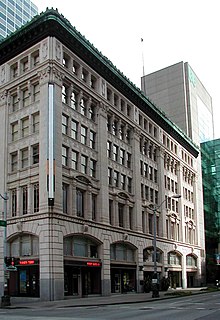
The Eagles Auditorium Building is a seven-story historic theatre and apartment building in Seattle, Washington. Located at 1416 Seventh Avenue, at the corner of Seventh and Union Street, the Eagles Auditorium building has been the home to ACT Theatre since 1996. It was listed on the National Register of Historic Places (NRHP) on July 14, 1983. has two stages, a cabaret, and 44 residential apartments. From the outset, the building was also in part an apartment building, originally under the name Senator Apartments: the four-story grand ballroom was surrounded on three sides by apartments. with many of the apartment buildings located near streetcar lines. The current configuration of the building, under the official name Kreielsheimer Place, has two stages, a cabaret, and 44 residential apartments.

The Alaska Building, which now houses the Courtyard by Marriott Seattle Downtown/Pioneer Square, is a 15-floor building in Seattle, Washington completed in 1904 to designs by St. Louis architects Eames and Young. At the time of its completion, it was the tallest building in the state of Washington—and remained so until the 1910 completion of Spokane's Old National Bank Building.
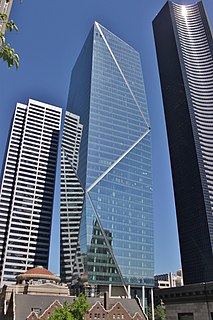
F5 Tower is a 660-foot-tall (200 m) skyscraper in Downtown Seattle, Washington. It consists of 44 floors and is the sixth-tallest building in Seattle.
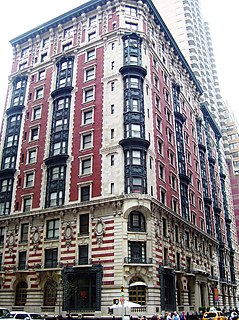
The James New York – NoMad, formerly the Seville Hotel and Carlton Hotel, is a historic hotel building at 22 East 29th Street and 88 Madison Avenue in the NoMad neighborhood of Manhattan, New York City. It was designed by Harry Allan Jacobs and built in 1901–04 in the Beaux-Arts style, with an annex built in 1906-07 which was designed by Charles T. Mott.
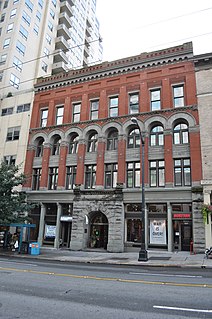
The Grand Pacific Hotel is a historic building in Seattle, Washington located at 1115-1117 1st Avenue between Spring and Seneca Streets in the city's central business district. The building was designed in July 1889 and constructed in 1890 [Often incorrectly cited as 1898] during the building boom that followed the Great Seattle Fire of 1889. Though designed as an office building, the Grand Central had served as a Single room occupancy hotel nearly since its construction, with the Ye Kenilworth Inn on the upper floors during the 1890s. The hotel was refurnished and reopened in 1900 as the Grand Pacific Hotel, most likely named after the hotel of the same name in Chicago that had just recently been rebuilt. It played a role during the Yukon Gold Rush as one of many hotels that served traveling miners and also housed the offices for the Seattle Woolen Mill, an important outfitter for the Klondike.

Arthur M. Garbutt was an architect who practiced in Fort Collins, Colorado and Casper, Wyoming. He worked from approximately 1903 to 1928.

The Monte Cristo Hotel is a historic building located in Everett, Washington. It is a major feature of the city's downtown core. It ceased functioning as a hotel in 1972. It was listed on the National Register of Historic Places on June 3, 1976. In 1994 it was restored and redeveloped into low income housing.
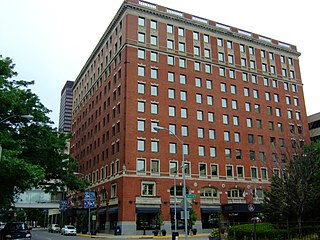
The Savery Hotel, now known as the Renaissance Des Moines Savery Hotel, is a historic building located in downtown Des Moines, Iowa, United States. This is the third hotel in the city with that name and the second at this location. The prominent Chicago hotel design firm H.L. Stevens & Company designed the 233-room hotel in the Colonial Revival style, which was a rare choice for commercial architecture in Des Moines. The hotel is an eleven-story brick building that rises 140 feet (43 m) above the ground. Opened in 1919, it has additions completed in 1952 and 1953. Across the alley to the west is an annex that was completed c. 1899 for the previous hotel building. During World War II, Des Moines was the location for the first Women's Army Auxiliary Corps (WAAC) training center. The Savery augmented the facilities at Fort Des Moines and served as the induction center, barracks, mess hall, and classrooms from 1942 to 1945.

Carl L. Linde was an American architect based in the Pacific Northwest of the United States, particularly in Portland, Oregon. Several of his works are listed on the National Register of Historic Places.
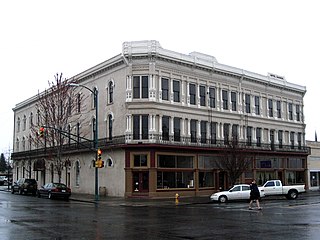
The Dacres Hotel is a historic hotel in Walla Walla, Washington, United States. Rebuilt from the ruins of Walla Walla's first brick hotel, the 1873 Stine House, the Italianate building was re-opened in 1899 by James E. Dacres. The building is a rare and exceptional local example of the pre-fabricated cast iron facades manufactured by the Mesker Brothers. Bennes, Hendricks & Tobey remodeled the building in 1907. It was added to the National Register of Historic Places on November 5, 1974.

The John Nolen Plan of Venice Historic District is a U.S. historic district located on the west coast of Venice, Florida. The district, planned by John Nolen in 1926 for the Brotherhood of Locomotive Engineers, is bounded by Laguna Drive on north, Home Park Road on east, the Corso on south, and The Esplanade on west. The district encompasses many other properties and historic districts already listed on the National Register of Historic Places including:

The Colonial Hotel is a historic building in Seattle located at 1119-1123 at the southwest corner of 1st Avenue and Seneca Streets in the city's central business district. The majority of the building recognizable today was constructed in 1901 over a previous building built in 1892-3 that was never completed to its full plans.

The Colonnade Hotel first known as the Stimson Block then later the Standard Hotel, Gateway Hotel and Gatewood Hotel is a historic hotel building in Seattle, Washington located at the Southeast corner of 1st Avenue and Pine Streets in the city's central business district. One of the earliest extant solo projects of architect Charles Bebb, it was built in 1900 by Charles and Fred Stimson, owners of the Stimson lumber mill at Ballard, for use as a hotel. It served that purpose under its various names until the early 1980s and after a brief vacancy was restored into low-income housing by the Plymouth Housing Group. Once owned by the Samis Foundation, it was sold to various LLC owners who would convert it back into a hotel in 2017, currently operating under the name Palihotel. It was added to the National Register of Historic Places on August 7, 2007 and became a City of Seattle Landmark in 2017.
